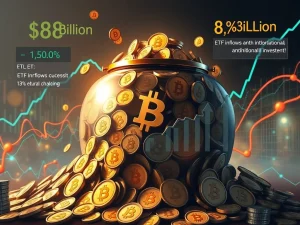Bitcoin ETF: BlackRock’s Astonishing Supply Grab Signals Market Shift

Get ready for a deep dive into the evolving world of Bitcoin. BlackRock’s Bitcoin ETF has been making waves, accumulating a significant portion of the total Bitcoin supply. This massive accumulation by institutional investors through vehicles like the Bitcoin ETF is reshaping the market landscape, even as signs suggest that retail investors might be taking a breather.
BlackRock’s Dominance in the Bitcoin ETF Space
BlackRock, the world’s largest asset manager, has quickly become a powerhouse in the spot Bitcoin ETF market since the funds launched in January 2024. Their iShares Bitcoin ETF (IBIT) is rapidly approaching the $70 billion mark in assets under management.
Consider these key figures:
- IBIT holds over $69.7 billion worth of BTC.
- This represents more than 3.25% of the total 21 million Bitcoin supply.
- IBIT commands over 54.7% of the market share among all US spot Bitcoin ETFs.
- Collectively, US spot Bitcoin ETFs now hold 6.12% of the total Bitcoin supply.
This rapid growth has propelled IBIT into the ranks of the world’s largest ETFs, positioning it as the 23rd largest globally across crypto and traditional finance products.
Institutional Investors vs. Retail Inflows: Is New Money Drying Up?
While ETFs see consistent inflows, some analysts point to a potential shift in who is driving market activity. Onchain data indicates that large-value transactions are dominating the Bitcoin network.
Here’s what the data shows:
- The average transaction size on the Bitcoin network is approximately $36,200.
- Transactions exceeding $100,000 now account for over 89% of network activity.
This concentration of activity among large players reinforces the view that institutional investors and high-value participants are increasingly dominant.
Conversely, the picture for retail investors appears different. The cohort of short-term holders, often seen as representing newer market entrants, has decreased significantly. This group held 5.3 million BTC on May 27 but has since fallen to 4.5 million BTC, a reduction of over 800,000 BTC. This decline suggests that ‘new money’ inflows from retail investors might be slowing.
Analyzing the Dynamics of Bitcoin Supply Absorption
The significant accumulation by entities like the BlackRock Bitcoin ETF is absorbing a substantial portion of the available Bitcoin supply. This institutional demand is helping to offset selling pressure from sources like miners and those taking profits after the recent price rally.
Market analysts note that long-dormant wallets are also becoming active, absorbing supply alongside corporate treasury strategies and large investor accumulation. This absorption dynamic is critical in the current market environment. While inflows into ETFs remain positive, the overall market sentiment and potential for a significant price breakout may require a new catalyst, especially if retail investors continue to show reduced interest.
Should investor demand weaken further, some analysis points to the onchain realized price of $92,000 as a significant support level, historically acting as a floor during bull cycles.
What This Means for the Bitcoin Market
The growing influence of institutional investors and the dominance of large transactions signal a maturation of the Bitcoin market. While the enthusiasm around the Bitcoin ETFs brought significant capital, the data suggests that the market structure is increasingly being shaped by larger players.
The potential slowdown in new retail investors entering the market, coupled with ongoing profit-taking, highlights the current supply-demand dynamics. For Bitcoin to achieve its next major price movement, a renewed surge in demand or a shift in broader market sentiment may be necessary.
Summary: Institutional Might Meets Retail Slumber?
BlackRock’s Bitcoin ETF has rapidly become a colossus, holding over 3.25% of the total Bitcoin supply and dominating the US spot ETF market. This impressive accumulation by institutional investors underscores the growing mainstream adoption of Bitcoin as an asset class.
However, onchain data suggests a potential cooling among retail investors, with large transactions making up the bulk of network activity. While institutional demand continues to absorb supply, the market may be searching for its next catalyst to push prices higher. The interplay between sustained institutional interest and the potential return of retail investors will be key to watching the Bitcoin market evolve.









